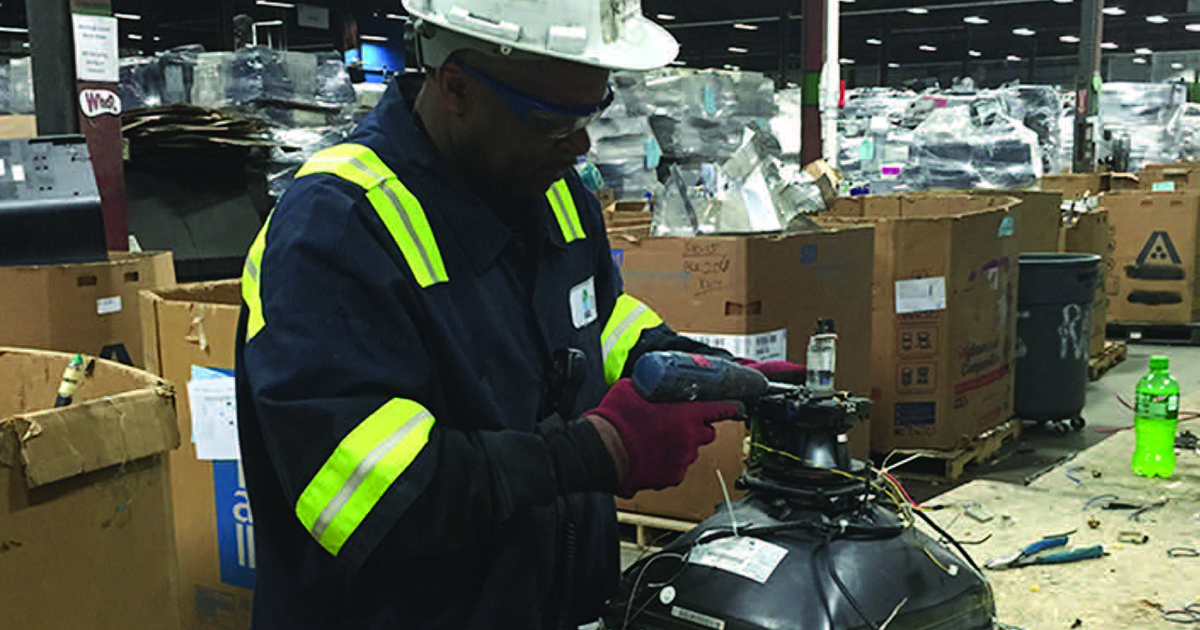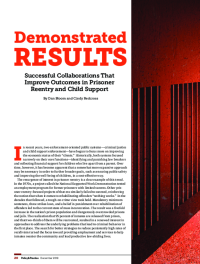Demonstrated Results
Successful Collaborations That Improve Outcomes in Prisoner Reentry and Child Support

This piece originally appeared in the December 2018 issue of Policy & Practice, the magazine of the American Public Human Services Association.
In recent years, two enforcement-oriented public systems — criminal justice and child support enforcement — have begun to focus more on improving the economic status of their “clients.” Historically, both systems focused narrowly on their core functions — identifying and punishing law breakers and collecting financial support for children who live apart from a parent. Over time, however, it has become apparent that a somewhat more expansive approach may be necessary in order to further broader goals, such as ensuring public safety and improving the well-being of children, in a cost-effective way.
The resurgence of interest in prisoner reentry is a clear example of this trend. In the 1970s, a project called the National Supported Work Demonstration tested an employment program for former prisoners with limited success. Other prisoner-reentry-focused projects of that era similarly failed to succeed, reinforcing the notion that when it comes to rehabilitating offenders “nothing works.” In the decades that followed, a tough-on-crime view took hold. Mandatory minimum sentences, three strikes laws, and a belief in punishment over rehabilitation of offenders led to the current state of mass incarceration. The result was a fivefold increase in the nation’s prison population and dangerously overcrowded prisons and jails. The realization that 95 percent of inmates are released from prison, and that two-thirds of them will be rearrested, resulted in a renewed interest in approaches to address the underlying problems that lead to criminal behavior in the first place. The search for better strategies to reduce persistently high rates of recidivism turned the focus toward providing employment and services to help inmates reenter the community and lead productive, law-abiding lives.
Similarly, the idea of providing employment and other services to noncustodial parents (usually fathers) who are unable to meet their child support obligations due to unemployment or low earnings was first tested in the 1990s, but the prevalence of such services appears to have expanded in recent years — even though state expenditures on employment services are generally not eligible for federal matching funds under the child support program.
Introducing services into an enforcement system typically requires some level of interagency collaboration because agencies like corrections, parole, and child support usually have neither experience with nor dedicated funding for such services. Perhaps the simplest type of collaboration is a referral relationship in which parole officers or child support workers, for example, refer their clients to particular nonprofit programs or public systems that offer employment services. If the service programs have funding from other sources, then no money changes hands. Such referral relationships are far from simple in practice, but some agencies have attempted to go further to design and implement models that require much more intensive coordination and collaboration.
A recent example of such collaborative approaches is worth examining. At the federal level, the U.S. Department of Labor (DOL) and the U.S. Department of Health and Human Services (HHS) ran closely related demonstration projects.
The DOL Enhanced Transitional Jobs Demonstration (ETJD) and the HHS Subsidized and Transitional Employment Demonstration (STED) coordinated their efforts to better understand the effects of transitional jobs programs for a range of disadvantaged populations. Transitional jobs are temporary, subsidized jobs in the public or private sectors designed to provide hands-on work experience to “teach people to work by working.”
MDRC led the evaluation in both projects, which helped facilitate a successful partnership between the two federal agencies. The agencies maximized learning and efficiency by sharing the evaluation costs, data collection instruments, and ongoing parallel efforts around such things as consistent outcomes, performance measurement, and evaluation reports.
At the state and local levels, the tone of interagency collaboration was further cultivated through funding requirements, client referrals, and service delivery. Each of the seven sites in DOL’s ETJD project was required to demonstrate partnerships involving community-based programs and the appropriate enforcement agency (i.e., corrections and child support).
The institutional arrangements varied from site to site. In some cases, the grantee was a nonprofit employment services provider that reached out to state or local child support or justice agencies to ask for referrals. For example, in Fort Worth, TX, the ETJD grantee was a local workforce board and program representatives recruited participants at a new arrival orientation that was mandatory for individuals released from prison to parole supervision.
In a few sites, the collaboration was particularly intensive. For example, in San Francisco, the ETJD program was structured as a collaboration between the Mayor’s Office of Workforce and Economic Development, the county Department of Child Support Services (DCSS), and a local Goodwill Industries affiliate. DCSS staff recruited participants directly from the agency’s child support caseload, ran the study enrollment process, and managed the referral of parents to Goodwill. To further promote and facilitate participation in the transitional jobs program, DCSS agreed to release driver’s licenses that had been suspended due to nonpayment of child support and temporarily lowered parents’ child support obligations conditioned upon attendance at the Goodwill program. This collaboration was noted by program participants in interviews as being particularly appealing.
In Indianapolis, the grantee, Recycle Force, is a nonprofit social enterprise — a business with a social purpose — that recycles electronics. Through shared interests, a process developed collaboratively; state and local probation and parole agencies ensured that the programs had access to the individuals they sought to serve — those assessed at medium or high risk of recidivism (earlier studies have shown that reentry programing can be particularly effective for this group). In turn, Recycle Force allowed parole officers the opportunity to host check-ins with their clients at the worksite, avoiding disrupting their attendance at work and enabling the officers to better manage their caseloads. In addition, the program hired a former employee of the county child support agency to help participants review and under- stand their child support orders and, when appropriate, fostered a connection between the parent and the child support agency, which enabled clients to reduce child support debt to $1 per pay period and get their licenses reinstated.
Overall, the results thus far from the two demonstration projects are more positive than previous efforts, depending upon how one views the goals of such interventions. For example, nearly all of the programs succeeded in meeting their enrollment targets and increasing short-term employment and earnings far above those of the control group in the random assignment studies. However, few led to improvements in most longer-term outcomes. The San Francisco and Indianapolis programs, however, had stronger and more lasting impacts on earnings, employment, recidivism, child support, or a combination of these outcomes. It is not possible to say with certainty how much of the improvement in client outcomes is attributable to the collaborative nature of the service delivery, but it’s certainly a noteworthy consistency, especially given the rigor of the evaluation.
The ETJD isn’t the only example of such collaboration. The federal Office of Child Support Enforcement (OCSE) is sponsoring two demonstration projects. The Child Support Noncustodial Parent Employment Demonstration is evaluating employment services in eight states and involves various interagency coordination strategies in each site. The OCSE’s Procedural Justice Informed Alternatives to Contempt project is testing new strategies to avoid legal contempt proceedings for noncustodial parents who are not paying support; the strategies include dedicated child support caseworkers providing individualized case management and referrals to a range of services delivered through partnerships with outside service providers.
Reentry programs offering employment services and other supports are funded at the federal level by the Second Chance Act, the Reentry Employment Opportunities program, and other sources. The Council of State Governments Justice Center is running the Integrated Reentry and Employment Strategies initiative to help local corrections and community-based employment programs work together to match individuals with appropriate job services based on their combined employment and recidivism needs.
What has been learned through all of these recent collaborative efforts? A few points seem particularly important.
First, not all service providers are created equal. Some programs or agencies are not especially receptive to serving high-needs clients like those targeted in the collaborations described here because they may drag down performance indicators, which can affect future funding. This is likely short- sighted because the evidence suggests that services may have more impact for those who would fare worse without them. Moreover, specialized experience may matter. MDRC has rigorously tested eight transitional jobs programs for returning citizens. The two that produced sustained decreases in recidivism—Recycle Force and the Center for Employment Opportunities, which now operates in 21 cities—both had many years of experience with this population and closely coordinated efforts with the local criminal justice systems.
Second, targeting matters. Particularly in the reentry context, studies have shown that it is important to connect individuals with services quickly upon release. The best way to do that is through a partnership with parole or probation. And if reducing recidivism is a key goal, then targeting more expensive services to those at higher risk is likely to produce a bigger bang for the buck. (Of course, people who are at the lowest risk of recidivism may be equally needy, which creates difficult choices since resources are almost always limited.) Criminal justice agencies have the ability to identify the appropriate intensity of services based on formal risk-need assessment tools, which are used in most parole and probation agencies. These tools are costly and require extensive training to be properly administered, making them less practical for most com- munity-based programs.
Third, referrals may not be sufficient. Enforcement systems may need to change their standard operating procedures to allow programs to succeed. Requiring parolees to miss work for in-person check-ins may disrupt their ability to find and hold jobs. Withholding half of a father’s first paycheck from a relatively low-paying job for child support does not provide a strong incentive for him to persist in the formal labor market, which can further interfere with his ability support his children.
Other questions are still unanswered. While both the child support and justice systems have the authority to compel people to participate in services, there is no clear evidence about whether mandatory services work better than voluntary ones. Similarly, researchers and administrators are starting to look at how to target and deliver services early, before people have gotten into serious trouble. For example, employment services could be delivered at the point that child support orders are established rather than waiting until the parent falls into debt. In the justice context, employment services may be used as part of diversion or alternative to incarceration programs to reduce the odds that individuals will go to prison in the first place.






